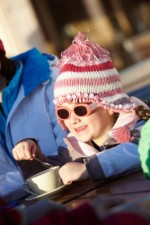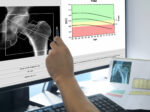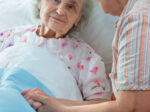 Cold injuries and illness occur in a wide range of physical activities affecting individuals at work such as the military, farmers, road workers, winter sport athletes or those involved in outdoor pursuits such as running, cycling, mountaineering and swimming.
Cold injuries and illness occur in a wide range of physical activities affecting individuals at work such as the military, farmers, road workers, winter sport athletes or those involved in outdoor pursuits such as running, cycling, mountaineering and swimming.
An understanding of the importance of sports nutrition and planning appropriate meals and snacks can offer some protection against cold injury and may also improve overall performance.
Physical responses to cold conditions
In order to find our vulnerability to cold injury it helps to first understand how the body responds to cold as it endeavours to increase heat production. This is achieved in two ways:
- Non-shivering activities that increase heat production without muscle contraction such as an increase in metabolic rate.
- Shivering, heat is produced by involuntary muscle contraction and reduced blood flow to the extremities (vasoconstriction) in an effort to prevent heat loss
Heat Loss
This occurs in 4 main ways:
- Radiation occurs when heat is lost directly to the environment via uncovered areas such as face, neck, head and hands and is greatest at night. This may be of concern to people who e.g.work outdoors at night or go tramping and camp out at night.
- Convection takes place when air passes over the skin due to wind or body movement such as when running, cycling and skiing. Appropriate clothing is essential to protection.
- Conduction occurs when the skin surface comes in direct contact with a cold surface such as rain, snow, water immersion or wet clothing. Conduction can increase heat loss by up to 5 times with wet clothing and 25 times with water immersion. So care must be taken, particularly of children when they go swimming for extended periods of time.
- Evaporation is a factor when heat is lost through respiration or sweating. Respiratory losses are difficult to control, other than wearing a surgical mask or scarf over the nose and mouth. While this may not be practical for some sports it should be considered for those susceptible such as young children who are asthmatics. Sweating can occur in sports such as ice hockey or mountaineering even when attempts are made to control heat by layering clothing and altering the level of activity.
The types of cold injury experienced
Hypothermia
This occurs at three different levels:
- Mild, core body temperature(cbt) drops below 35-37°C (95-98° F)
- Moderate cbt drops below 32-34°C (90-94°F)
- Severe cbt is less than 32°C( <90°F)
Prolonged exposure to cold, wet and windy conditions can result in hypothermia as experienced during endurance events, outdoor team sports such as soccer, football, mountaineering and hiking and in occupations requiring long periods outdoors or in unheated spaces. The rate of hypothermia injury is two times greater in females than males. Women lose body heat more quickly than men because they have a smaller total muscle mass and a larger surface area for convective heat loss.
Symptoms of hypothermia may include: cessation of shivering, very cold skin, impaired mental function, slurred speech and bad decision-making, impairment of gross motor functions, cardiac arrhythmia.
Frostbite
This can occur as a localised response to a cold, dry environment, although moisture can speed the process if sweating increases tissue cooling. Frostbite is characterised by freezing of body tissues and like hypothermia it also occurs in stages as warm blood is shunted from cold extremities to maintain a higher core temperature. The superficial tissue of hands, face, nose and ears may be the first affected when the temperature drops below -2°C( 28°F) followed by a progression to deeper tissue.
Symptoms may include swelling, mottled grey skin, transient tingling and numbness in the limbs.
Treatment for hypothermia and frostbite should include slow re-warming by applying heat first to the body trunk not extremities. Alcohol and nicotine should be avoided.
Chilblains
This is an inflammatory response to exposure to cold, wet conditions over a period from 1-5 hours at temperatures of 16 deg C (<50°F) resulting in swelling of the affected tissue, tenderness, itching and pain. Treatment should include drying the affected tissue, elevation and covering the affected area with loose, warm clothing or blankets.
Bronchoconstriction
This may affect asthmatics when the inhalation of cold air increases the respiratory heat loss triggering an attack. Those involved in high intensity activities such as skiers, cyclists and runners may be more at risk.
Risk factors to health
When placed in a cold environment some individuals will be more susceptible than others to cold injury for example:
Previous cold injury
Those who have had frostbite in the past are 2-4 times as likely to be affected again if the same area is exposed to similar environmental conditions as was first experienced
Low energy Intakes
People who consume low energy intakes e.g.1200-1500calorie intakes, suffer from hypoglycaemia (low blood sugars) or both are more likely to experience a drop in metabolic rate and heat production
Dehydration
Dehydration may not affect shivering however when fluids are lacking the distribution of energy to the muscles slows, thereby compromising recovery.
Fatigue
If people experience fatigue and this is accompanied by hypoglycaemia then peripheral circulation can be impaired along with the shivering response. Tiredness can result in poor decision-making and thereby lead indirectly to injury.
Race
Darker skinned individuals are 2-4 times more likely than other ethnic groups to sustain cold injury. This is due to such things as anthropometric and body composition differences; a reduced cold induced vasoconstriction response and such things as thinner longer digits.
Alcohol and drugs
Alcohol consumption has the effect of reducing glucose concentration in the blood and (as with drugs) can reduce the shivering response as well as altering mental functions which in turn can lead to bad decision-making and injury.
Children
They have a larger surface area than adults, when calculated per unit of body mass and they also have less fat to prevent heat loss. As a result, the smaller the child, the greater and more rapid, the heat loss. Their state of health is also important. Some children are smaller and thinner as a result of malnutrition, disordered eating or congenital health issues such as cystic fibrosis, heart defects and failure to thrive. These children need extra care and supervision when taking part in activities that expose them to cold conditions.
Obviously the length of time a child is exposed to cold conditions will affect the severity of change in their performance. Children who resist feelings of cold discomfort in order to continue performing in sports such as swimming may be at greater risk of hypothermia. Regular supervision of the time spent in swimming pools during training and competition is important. During swimming practice children should be allowed to come out of the water every 15-20 minutes to avoid hypothermia.
Older people
As people age there is a reduction in sympathetic nervous function reducing vasoconstriction and increasing heat loss. This can also be a problem when combined with medications or medical conditions such as cardiovascular disease, diabetes, hypothyroidism and hypertension. Athletes who enter races after 55yrs of age should have regular medical check- ups with their doctor.
Spinal injuries
People who have suffered spinal cord injuries (SCI’s) are at greater risk of hypothermia, abnormal blood pressure, numbness with cold, pain and muscle spasm. Care must therefore be taken when athletes with SCI’s compete in cold conditions.
Nutritional tips if working or competing in cold conditions
- Start the day with a breakfast that includes hot foods such as porridge or cereal with hot milk; toast; a yoghurt, egg or cheese slice or baked beans.
- If working or exercising in a cold environment take extra food supplies with you in case you are caught by delays or road closures. Choose foods that are portable, easy to access and handle. For more information on workplace nutrition read Lea’s article: Put sports nutrition to work
- Good hydration is particularly important. Plan to have hot drinks, soup, trim hot chocolates and water readily available throughout the day and avoid alcohol consumption.
- If venturing into alpine areas, hiking or mountaineering take extra dehydrated foods, portable cookers and gas and high energy snacks such as scroggin, cereal bars and dried fruits.
- If catering for children involved in winter camps such as skiing or adventure camps at school plan menus to include hot foods and snacks with plenty of carbohydrate for energy in the form of cereals, bread, pasta and rice, fruit and vegetables. Ensure that children also carry snack foods and drink bottles with them in case they become separated from their group.
- Children involved in water sports such as swimming need to be carefully supervised. Read Lea’s article Swim for life for more information on when and what to eat during training and competition.
- For those athletes affected by asthma read Lea’s article on Diet may help exercise induced asthma
- Older athletes need to check regularly with their doctor to ensure that the doses of any medications they may be taking is appropriate to their body weight and activity levels. For more information read Lea’s article on Sports nutrition for senior athletes
If you are suffering from fatigue on a regular basis then talk to you doctor and contact us to ensure that your nutritional intake matches the energy demands of your sport and daily life.
References:
Burke.L, Deakin V. Clinical sports nutrition. McGraw Hill Australia 2nd ed 2000 Chapter 14, 378-9.
Bar-Or O, Children’s responses to exercise in cold climates: health implications. Sports science exchange Gatorade sports institute 51 vol 7 1994 no 4.
Cappert T; Stone J; Castellani J; Krause BA; Smith D; Stephens B. National athletic trainer’s association position statement: Environmental cold injuries. Journal of athletic training 2008 v 43 (6) Nov-Dec 640-658.































































Leave a Reply